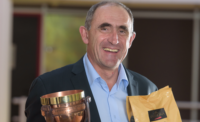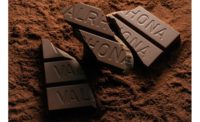Each year, the Valrhona Innovation team manages about 80 projects. Of those, between 10 to 20 actually are launched, says Christophe Devaux, R&D project manager. It is a time-consuming process, he concedes. But it’s the only way a company passionate about “doing the best to be the best” can operate.
With more than 25 years’ experience in chocolate — with a good 10 years grounded in supervising chocolate production — Devaux recognizes the difference between the lab bench and the moulding line.
As a member of the 20-person innovations team consisting of engineers and technicians, he is one of the interfaces between production and marketing, the judge between daunting and doable.
Fortunately, Valrhona’s management team believes in doable, as evidenced by the eight-year effort behind the company’s introduction of the blond-colored chocolate, Dulcey, several years ago. Discovered by Frederic Bau, the company’s executive pastry chef, as a result of leaving white chocolate in a water bath for 10 hours, Dulcey delivers a different white chocolate experience. Its blond color complements its shortbread taste and creamy texture perfectly.
Although it was initially replicated and used at the Valrhona’s Ecole Valrhona extensively, transforming the discovery into an all-natural commercial product took some effort. As Devaux says, “It wasn’t easy to make it on an industrial scale.”
But then easy isn’t what Devaux and his crew are all about.
“We have tremendous freedom in exploring new ideas,” he explains. It’s all about thinking outside the chocolate bar, breaking barriers, “expanding what chocolate can mean,” Devaux emphasizes.
“Can we have red chocolate, salt and pepper chocolate?” he asks rhetorically. In reviewing the wide range of chocolate flavors currently available, Devaux believes there’s a gap in the palette, specifically in the savory range. But no need to worry; he’s on it.
As a key member of Valrhona’s vaunted taste panels, the R&D project manager tastes the new incoming lots of beans daily. As he explains, “You can appreciate the quality of chocolate then.”
A big fan of the company’s newly released double-fermented couvertures — Itakuja 55%, a Brazilian couverture fermented with passionfruit and Manaka 62%, a Madagascan couverture fermented with orange juice — Devaux also loves blending origins together.
In fact, he says that’s part of the Valrhona’s genius, citing Guanaja, the world’s “bitterest chocolate” that was launched 30 years ago, and Caraïbe, a balance of smooth chocolate and roasted dried fruit notes with a slight oaky finish.
“These are two emblematic chocolates,” he says. “Geography isn’t important to me; rather, what I’m looking for is flavor. I want to find the best marriage for the beans, inducing harmony between the origins as it relates to bitterness, fruitiness, acidity, and floral notes.”
Devaux adds that it’s important to know the profile of each origin to do so. And, of course, he’s intimately familiar with all of the origins.
“I potentially have a new blend ready to launch,” he says. “It’s just a matter of pushing the marketing team.”
Expect a nudge and a launch soon, not to mention a new chocolate experience.
See also: Photos from the European Candy Kettle Club Reception
See also: ‘The Valrhona way’: What makes Jean-Luc Grisot's leadership so special?




